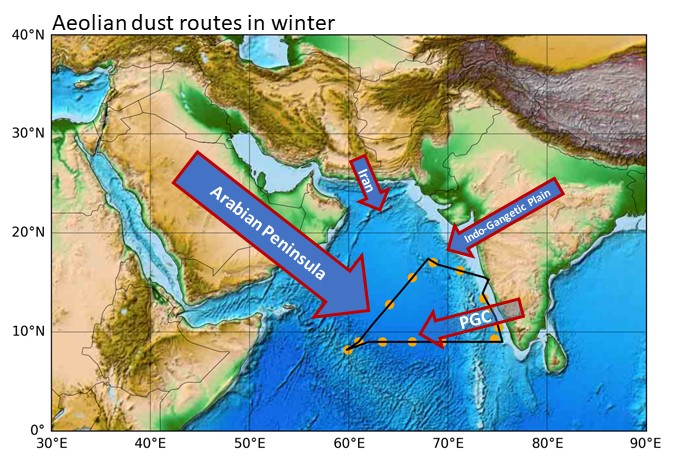Ministry of Science & Technology
Dust from Middle East Fuelling the Arabian Sea Productivity
प्रविष्टि तिथि:
26 OCT 2023 5:41PM by PIB Mumbai
Goa : 26 October 2023
Dust particles uplifted by the wind over the deserts are an essential contributor of nutrients and trace metals to the microscopic surface-dwelling plants, aka phytoplankton, in the global ocean. Despite its significance, the overall impact of dust deposition on the Arabian Sea is not well understood and the biogeochemical modellers often rely upon qualitative parameterisation of dust source regions based on satellite remote sensing products. The dynamics of dust transport and its impact on the Arabian Sea, according to numerous researchers, is that this process occurs mainly during the summer season, and the air parcels transported in the winter season to the Arabian Sea are dominated mainly by the smoke particles (e.g., soot, sulphates and nitrates). Although surrounded by several aid land masses, it is not clear which dust source is most likely contributing to mineral aerosols over the Arabian Sea in the winter. In contrast to this conventional wisdom, a study carried out at CSIR-National Institute of Oceanography, Dona Paula, Goa based on the Sr and Nd isotopic composition of mineral dust particles collected over the Arabian Sea during a winter cruise, for the first time, confirmed the influence of dust storms from Saudi Arabia/Iran.
The dust particles were collected onboard R/V Sindhu Sadhana during an expedition in the Arabian Sea, one of the several ongoing research cruises in the Indian Ocean, an Indian effort towards the international program called GEOTRACES to understand the behaviour of trace metals across the air-sea interface and within the water column. Based on the origin of each air parcel transport pattern, the measured diagnostic tracer pair is compared with those reported for surface soils/bedrock terrains of desserts in the Middle East and South Asia.

During the expedition, the research team encountered two specific dust storm events over the Arabian Sea. The first dust storm sampled over the Arabian Sea on 27 January 2020 was originated from Saudi Arabia. In contrast, the second dust storm sampled over the Arabian Sea on 10 February 2020 was mainly sourced from Iran and the Indo-Gangetic Plain (IGP) in India. Interestingly, the isotope signature of the first storm resembles the other dust samples collected over the central Arabian Sea, thus signifies the importance of dust outbreaks from the Arabian Peninsula contributing mineral dust in the winter season. Overall, this study highlights the importance of dust storms in the Middle East on the Arabian Sea during the winter season. However, the south-eastern Arabian Sea does get dust from peninsular India. These dust particles are the major source of minerals and nutrients to the Arabian Sea fuelling the productivity in the region and helping sequester the atmospheric CO2.
“Link of the short-term temporal trends of Sr and Nd isotopic composition of aeolian dust over the Arabian Sea with the source emissions, Science of the Total Environment, 2023, vol.892; 2023; Article no: 164680”
GSK/PM
Follow us on Social Media: @PIBPanaji
@PIBPanaji  /PIBPanaji
/PIBPanaji  /pib_goa
/pib_goa  pibgoa[at]gmail[dot]com
pibgoa[at]gmail[dot]com  /PIBGoa
/PIBGoa
(रिलीज़ आईडी: 1971592)
आगंतुक पटल : 438
इस विज्ञप्ति को इन भाषाओं में पढ़ें:
Marathi